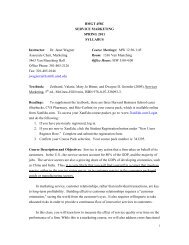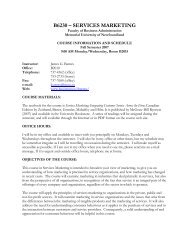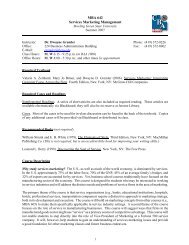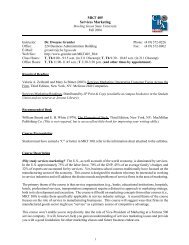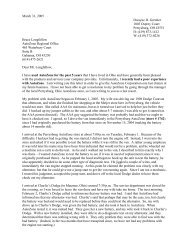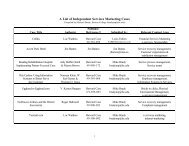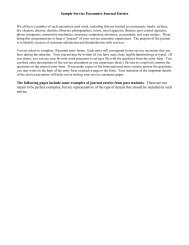Rapport-Building Behaviors Used by Retail Employees - Gremler.net
Rapport-Building Behaviors Used by Retail Employees - Gremler.net
Rapport-Building Behaviors Used by Retail Employees - Gremler.net
You also want an ePaper? Increase the reach of your titles
YUMPU automatically turns print PDFs into web optimized ePapers that Google loves.
D.D. <strong>Gremler</strong>, K.P. Gwinner / Journal of <strong>Retail</strong>ing 84 (3, 2008) 308–324 311ees. Participants responding in the role of the customer receivedthe following instructions:Think of a time when you had an experience with a servicecompany or retailer where the employee attempted toestablish rapport with you. In particular, we are interested insituations where an employee specifically sought to create awarm, enjoyable interaction in an attempt to ‘connect’ withyou (the customer).Respondents provided information about the company, typeof service, location of the company, and when the incident tookplace. They then responded to a series of questions to assist theirrecall of the incident. Questions specifically prompted them todescribe the incident, recount what the employee specificallysaid or did in an attempt to establish rapport, disclose theirresponses to the actions of the employee, explain why this incidentstood out, and report whether they continued to patronizethe organization after the incident.Employee respondents received similar instructions thatasked them to think of a time they attempted to establish rapportwith a customer and then describe that interaction in detail.Data collection proceduresWe collected the data in two waves. In Sample 1, 77 undergraduatestudents enrolled in an introductory marketing courseat a public university in the western United States participatedas data collectors as part of a class assignment. This techniquehas been used successfully in a variety of studies (e.g.,Bitner et al. 1990; Gwinner et al. 1998; Keaveney 1995), especiallyCIT research (<strong>Gremler</strong> 2004). Prior to data collection,students received training in the CIT method, including anoverview and examples of appropriate and inappropriate (e.g.,incomplete) responses. In addition, the training instructed studentsto terminate the interview and seek another respondentwhen a respondent was unable to think of a rapport-buildingincident.<strong>Gremler</strong> (2004) recommends that content analytic CIT studiesshould not use the same data set to develop and verifyclassification schemes. Therefore, we collected a second set ofdata to serve as the verification (confirmation) sample. Specifically,64 undergraduate students enrolled in services marketingcourse at a public university in the Midwestern United Statesserved as data collectors for Sample 2. The procedures are identicalto those used for Sample 1. 22 In an attempt to encourage authentic responses, we undertook two mainactions. First, the instructions to the student data collectors included a warningthat the fabrication of an incident to complete the assignment would be consideredcheating and those violating this requirement would have to deal withuniversity authorities. Second, the instructions indicated respondents would berandomly selected and contacted for a verification check (the survey included arequest for a first name and a daytime telephone number). A visual inspection ofthe questionnaires indicated sufficient variability in both handwriting and patternsacross responses, as well as consistency within individual responses. Also,we randomly selected 35 respondents from Sample 1 and telephoned them todetermine if they had participated in the research; 30 indicated that they had, andthe remaining 5 could not be reached during three attempts. In those situations,Classification sampleThe student interviewers collected 300 critical incidents forSample 1, of which 273 (91%) are suitable for use. The remaining27 incidents (15 completed <strong>by</strong> customers, 12 <strong>by</strong> employees)are not appropriate as input for understanding employee attemptsat rapport building, according to the criteria listed in the codinginstructions in Appendix A.The critical incidents determined usable include stories told<strong>by</strong> 133 customers (49% of the sample) and 140 employees.The sample is even in terms of gender, consisting of 137 menand 136 women. The customer respondents range in age from18 to 71 years, with an average age of 29.3 years (standarddeviation = 11.6); the age range of employee respondents is18–53 years, with an average age of 26.1 years (standard deviation= 8.0).Verification sampleIn Sample 2, the students collected 127 critical incidents, ofwhich 115 (91%) are suitable for use, according to the criteriain Appendix A. The usable incidents come from 59 customers(51% of the sample) and 56 employees. In this sample, 72respondents (63%) are women. The customer respondents inthe sample range in age from 20 to 65 years, with an averageage of 38.2 years (standard deviation = 12.2); the age range ofemployee respondents is 20–73 years, with an average of 42.5years (standard deviation = 12.8).Data analysisCategory developmentAs our review of rapport literature suggests, retail employeesmight use four broad categories of behaviors to build rapportin a commercial setting: attentive, common grounding, imitative,and courteous behavior. These four categories served asthe a priori starting point for developing our CIT classificationscheme.To construct a classification scheme of rapport-buildingbehaviors, two researchers – the lead author and another expertin the field (i.e., Judges A and B, respectively) – collected, read,reread, sorted, and resorted the critical incidents from Sample1. This effort revealed that many incidents include more thanone discrete rapport-building behavior. Consistent with priorresearch (Bendapudi and Leone 2002; Keaveney 1995), JudgesA and B determined that the discrete behaviors noted withineach critical incident, rather than the entire critical incidentstory, provide the most appropriate unit of analysis and bestpreserve the specificity of the data. The judges then discussedthe general themes that emerged, and Judge A developed a classificationscheme with five broad categories of rapport-buildingbehaviors, fairly consistent with the a priori categories. JudgesA and B further analyzed and discussed the behaviors in eachcategory, which resulted in the development of more specificsubcategories of rapport-building behaviors (fourteen in all). Italso led to the creation of instructions that other judges couldwe contacted a different respondent from that data collector’s set to verify studyparticipation. Overall, we conclude that the data collected are authentic.



